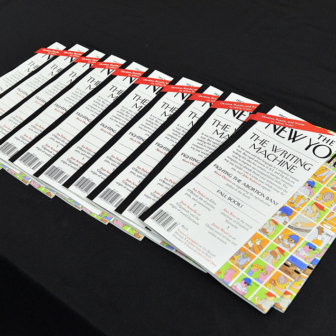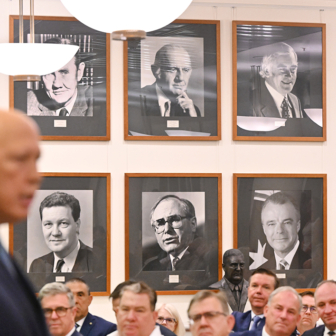Today’s announcement of the merger of Nine and Fairfax is the biggest and most significant media deal for decades, and one of the most significant in the nation’s history. The implications for Australian public life are enormous.
Not that it is a complete surprise. Ever since last year’s change to media ownership regulations — including the removal of the ban on any entity owning print, television and radio platforms in a single market — something like this has been almost inevitable.
This deal is effectively a Nine buyout of Fairfax. Over the next few months and years, the Fairfax name will disappear. Thus ends a long and mostly honourable period in which the company has been associated with quality journalism and has stood as the main counter to Murdoch’s News Corporation.
This announcement also means a reduction in the diversity of ownership of mainstream journalism outlets in Australia, and that is very bad indeed. Most obviously, Fairfax’s rural, suburban and regional publications, including important local titles such as the Launceston Examiner and the Newcastle Herald, clearly have no future as part of the new entity. In the teleconference for investors and analysts this morning, Nine CEO Hugh Marks was quite clear about that.
The focus of the new entity will be on high-growth digital assets, and the regional Fairfax newspapers would do better “in some other environment,” he said. In other words, they will be dumped. Probably they will close, unless they are bought up by local people who value their content.
Given that the deficits that have emerged in journalism over recent months are mostly about the hollowing out of local journalism, this is devastating to the civic and democratic health of local communities.
What about the flagship Fairfax mastheads — the Age, the Sydney Morning Herald and the Australian Financial Review? It is by no means certain that the Age and Sydney Morning Herald have a healthy future either. The new entity will “review the scope and breadth of the combined business to align with its strategic objectives and its digital future.” That statement contains a chilling message for print journalism.
Fairfax CEO Greg Hywood said that the metropolitan publishing business is sound — and more cost efficiencies were announced recently, in the form of shared printing presses with News Corporation. So the mastheads will probably have a diminished future, for a while, but the medium-term implications are dire.
The main value of the mastheads to Australia is, of course, their journalism — not the dollars they earn. Without Fairfax journalism, we would not have a royal commission into the banks, and we wouldn’t have had one into institutional sexual abuse either (with Joanne McCarthy’s Newcastle Herald reporting being key).
But as far as the dollars are concerned, today’s announcement sees the mastheads’ main value to be their role as a vehicle for Domain’s real estate advertising. But this value seems likely to be reduced by the buyout, since the new entity has a much bigger reach through its broadcast assets.
From a business point of view, of course, it’s all gravy. Both Nine and Fairfax have been written off as legacy media businesses going out backwards. From that perspective, this is a bit of a turnaround — and Marks and Hywood were not backward in pointing out their cleverness this morning.
Hywood has stripped costs — reducing the newsrooms to a size he claims is sustainable — while overseeing the growth of valuable businesses including Domain and the subscription television service Stan, already owned in partnership with Nine. The result is a sufficiently tasty morsel for sale.
Marks opened his remarks to investors and analysts this morning by foreshadowing that the new Nine will pioneer highly targeted advertising using data gleaned from across the platforms — including Stan and Fairfax Digital. But if it’s targeted, it comes at you on the web, not necessarily linked to quality journalism. The risk is that the journalism becomes no more than a cost centre, and thus at risk of being further diminished.
In Marks’s teleconference this morning there was the usual rhetoric about journalism being central to the new entity — but the hard facts and figures are all about advertising separated from the mastheads. For its part, Domain might be a success story for now, but it is hardly a sure thing in the medium to long term. The other headlines on Fairfax’s news sites today are about a dip in the real estate market.
The potential for estate agents to start up their own platform hangs as a constant threat over the Domain enterprise, should it ever try to gouge or otherwise annoy them. Domain might well be at its peak right now — which probably drove some component of the timing behind today’s announcement.
But none of this is about the main value of Fairfax to Australian civic life. None of it is about journalism. On this score, it is interesting to note that Nine’s board is chaired by former Liberal treasurer Peter Costello, who led the anti-ABC forces in the Howard government. Costello was also notorious for trying to pressure individual journalists at Fairfax, with some former editors perceived as being too malleable under that pressure.
This is important because the keynote journalism from Fairfax in recent times has often been done in partnership with the ABC, and particularly Four Corners. This has greatly increased its journalism’s reach and impact. It seems unlikely that those kinds of collaborations will be allowed to continue in the new entity.
Fairfax journalists will presumably be expected to collaborate with Nine if they’re seeking cross-platform reach. Nine has a very different journalistic culture from that of the main Fairfax mastheads: it is about commodified mass-market news, with little commitment to investigative journalism.
The ABC has repeatedly tried to poach the leading Fairfax investigative journalists — people like Nick McKenzie, Richard Baker and Adele Ferguson. They have been loyal to Fairfax. Now might be a good time for the ABC to try again, if it can find the dollars after recent budget cuts. Which of course signals the continuing importance of the public broadcasters in a time of media disruption — but that’s a topic for another day.
During this morning’s briefing, Hugh Marks said that the Nine board would have no trouble “adopting the principles” of the Fairfax Charter of Editorial Independence. He stopped short of saying they would sign it. But even if it were signed it doesn’t really mean much. That charter gains its heft from the preparedness of the journalists and their audiences to demand it and act to enforce it.
Fewer journalists competing for fewer job opportunities reduces that likelihood. The charter also places most power in the hands of the editors, and we don’t know who they will be. If the editor is a patsy, the charter is meaningless.
The announcement to the stock exchange from Fairfax and Nine talked about $50 million in costs cuts made possible by this merger. Marks declined to say where they would be drawn from, but obviously mergers of newsrooms, with resulting cuts, are likely to be part of the mix.
Some might see the ghost of Kerry Packer hovering over this deal. The former owner of Nine repeatedly tried to get his hands on Fairfax. But that would be misreading the context. The era of media emperors is over, the ageing Murdoch its last survivor. Today’s Nine is owned by private equity and institutions. Personality of ownership is no longer crucial to media content.
Marks and Hywood claimed they had no concerns that the Australian Competition and Consumer Commission would block the deal on the grounds of reduction of competition. They are probably right. But Google’s and Facebook’s power and conduct are currently under investigation by the commission’s Digital Platforms Inquiry, which will doubtless be following today’s announcement closely.
Today’s development is the inevitable result of governments failing to come up with good media policy. The focus has been on removing outdated regulations without thinking about what a modern, fit-for-purpose system of media regulation should look like.
Now more than ever, governments and civic leaders should be grappling with how a healthy future for Australian journalism, and thus for our democracy, can be assured. ●




